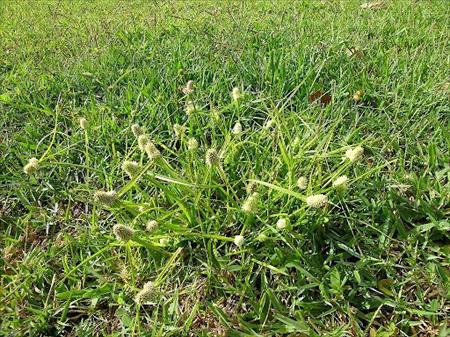Your Cart

Learn Your Lawn: Green Kyllinga
Request a Quote
Green Kyllinga is a perennial sedge with narrow, grass-like leaves. It’s a weed species commonly found in regions with warm, humid climates and abundant rainfall, which allow the weed to thrive and spread rapidly. It is known for its invasive and competitive nature. In the late spring or early summer, it will grow more rapidly than most turfgrasses, crowding out desirable species. Green Kyllinga can have up to three dark green leaves, ranging on average from 2 ½ - 6 inches in length. The leaves are hairless and have a glossy sheen with tiny barbs that are rough to the touch. Green Kyllinga emerges in late spring and grows throughout the summer months until the first killing frost. Once growth ceases, the leaves turn brown and the plants will enter winter dormancy. Green Kyllinga reproduces primarily through rhizomes and underground tubers. An effective way to control small infestations of Green Kyllinga is to pull up individual plants by hand and then repair these areas with desirable grass seed varieties or sod. If the infestation is larger, other forms of control may be necessary. A thick, healthy, well-maintained lawn is always the best line of defense. This can be achieved through beneficial cultural practices, which include: Core Aeration: Aerating your lawn can improve soil drainage and help reduce the likelihood of lawn diseases. This will also alleviate soil compaction and allow water and nutrients to penetrate deeper into the soil. Fertilize Regularly: Regular applications of Weed Man’s specially formulated, slow-release granular fertilizer will help provide your lawn with adequate nutrients. These applications are timed specifically to avoid over fertilizing the lawn. Watering: Under normal circumstances, you should be watering your lawn a few times per week for 30-45 minutes in each area. During hot and dry periods, most lawns should be watered as much as required to maintain its desired green color. Always water in the early morning so the turf has time to dry by nightfall. Mowing: Maintain a regular mowing schedule with a razor sharp blade. Never remove more than a ⅓ of the grass blade at each mowing. Recommended Mowing Height Common Bermudagrass - ¾ to 1¼ inches Hybrid Bermudagrass - ½ to 1½ inches Centipedegrass - 1 to 2 inches Zoysiagrass - 1 to 2½ inches St. Augustine - 3 to 4 inches Fescue - 3 to 4 inches Your local Weed Man professional will be able to offer other solutions and recommend the best form of treatment that is suitable to improve the conditions of your lawn.What Is Green Kyllinga?
How Can I Control Green Kyllinga In My Lawn?
 English (USA)
English (USA) Français (CANADA)
Français (CANADA)

